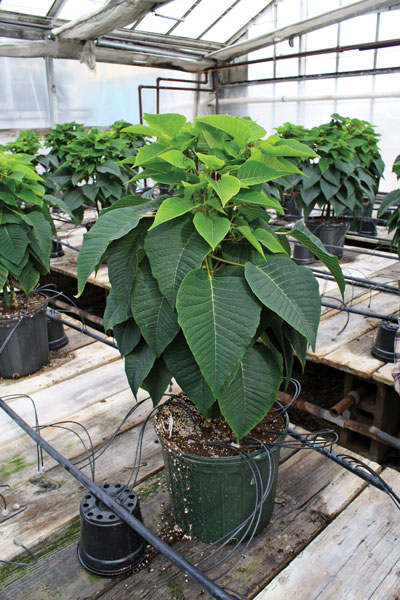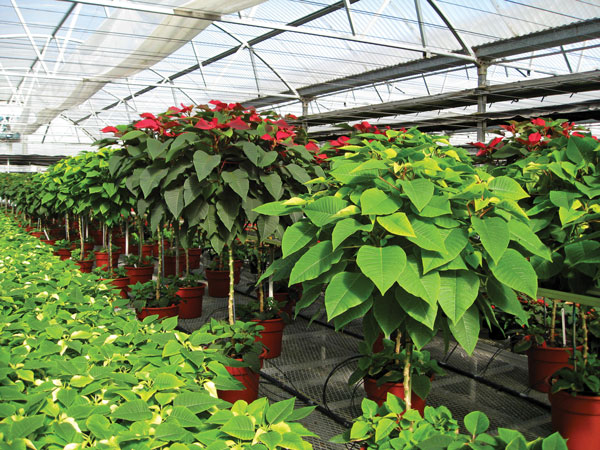5/1/2021
Fun Comes in Different Forms
Christopher J. Currey

Poinsettias are an important greenhouse crop, filling greenhouses every fall. The majority of these plants are most likely going to be a 6-in. container with a single, pinched cutting. This is by far and away the most common poinsettia form grown. However, it’s by no means the only one to grow. Whether it’s to have some product differentia-tion or to add value, consider growing a different type of finished poinsettia.
Trees
Poinsettia trees are where a single cutting is grown for an extended period of time, forming a “trunk,” then the plant is pinched and the branches form the “canopy.” Trees are an eye-catching form that can be produced in a variety of container sizes, from tabletop plants in 6-in. containers to trees more than 4- to 5-ft. tall in large nursery containers.
Compared to the regular pinched plants, trees have a longer production schedule. The larger the tree, the longer the production time required to unfold the leaves and achieve sufficient internode elongation. Plant growth regulators can also be used to help develop trunks. Instead of inhibiting stem elongation with anti-gibberellic acid (GA) growth retardants, GA3 foliar sprays ranging from 50 to 100 ppm can be applied during the vegetative growth phase when the trunk is being grown to promote stem elongation and increase stem height.
Figure 1. The canopy on this poinsettia tree is starting to develop. The leaves haven’t been removed from the trunk because the branches that will form the canopy are still developing.
As plants get taller, branches need to be removed from the trunk. Be sure to remove them before they get too large to avoid damaging the main stem. However, don’t be too aggressive and remove branches too close to where the pinch will occur—those are the branches required for canopy development. The old leaves on the trunk should be left until branches are well developed and you may want to leave a few under the branches, especially on smaller trees.
Poinsettia tree canopies can be developed in a variety of ways. Forming the canopy on poinsettia trees is the same as branch development in regular pinched poinsettia forms, with pinching for canopy development occurring earlier in production for the container as the finished plant size increases (Figure 1).
While multiple pinches may be required for the largest tree varieties, single pinches may be sufficient for trees finished in smaller containers. Also, while not required for small trees, staking the trunk can be advisable and sometimes necessary to add strength and support to large tree forms (Figure 2).
pinches may be required for the largest tree varieties, single pinches may be sufficient for trees finished in smaller containers. Also, while not required for small trees, staking the trunk can be advisable and sometimes necessary to add strength and support to large tree forms (Figure 2).
Figure 2. Poinsettia trees, finished and flowering, are one of the most striking specialty poinsettia forms. Consider staking taller forms to prevent damage and add strength.
Straight-ups
“Straight-ups,” “standards”—these are names for the same finished product: a container with multiple, un-pinched cuttings. The finished product these straight-ups or standards produce differ from the single pinched cutting form in a few ways.
First, the bracts on straight-ups are larger than those on the branches from a single, pinched cutting. Smaller branches can develop and, if left to develop, contribute to a fuller appearance. Additionally, compared to plants finished in the same pot size from pinched cuttings, the target for finished straight-ups or standard poinsettias is generally slightly higher. These attributes make the straight-ups or standards more of a “florist-quality” plant and, as such, they can command a higher price point.
The production time for straight-ups is shorter compared to the same size container with a pinched cutting or a multiple pinched cutting, since no period of vegetative growth after a pinch is required. The number of un-pinched cuttings increases with container size, with three to four cuttings per 6-in. container and up to seven to 10 cuttings for a 10-in. container. While the cost for cuttings increases for straight-ups compared to pinched plants, the increased value of the finished plants combined with the shorter bench time and decreased labor make straight-ups an attractive
alternative.
Minis and micros
Micro poinsettias are pretty much the opposite of trees—in a word, diminutive. They can be grown in both pinched and unpinched forms. Miniature poinsettias have a very short production time. However, no poinsettia, including minis, can be grown without a sufficient time under short days for flower induction—typically between 7.5 and 9.5 weeks. The majority of vegetative growth prior to short days is primarily for rooting
cuttings.
To direct-stick in the finished container, a single, unrooted cutting is planted in a 2.5- to 3-in. container filled with traditional finishing substrate—70% to 80% ground sphagnum peat moss and 20% to 30% coarse perlite. Given the smaller substrate volume in these smaller containers, managing substrate moisture is easier when direct sticking in these small containers compared to more common larger sizes.
To produce an unpinched mini, cuttings can be rooted directly just a few weeks prior to short days. If growing pinched forms, direct stick two additional weeks earlier. Additionally, remove the old leaves on the main stem of pinched plants a few weeks after short days, as these will be disproportionately larger than the new leaves formed on the breaks following pinching. Do not remove leaves on unpinched minis.
Mixed containers
Mixed containers may not be a specialty form of poinsettia, per se, but they’re certainly different. In a mixed patio pot or hanging basket, the three plant forms in the container are the thriller, spiller and filler. In a mixed poinsettia planting, the poinsettia is nearly always the thriller—the upright focal point of the container. Fillers and spillers—such as English ivy—green- and variegated-leaved varieties, and the white-bracted euphorbia hybrids are popular choices. But don’t be afraid to try something new!
As with any mixed container, not all species in a combination have the same requirements, from greenhouse environment and culture. The “plant-and-grow” method, where all components of a mixed container are planted and grown together throughout production, always results in the most natural finished-looking project. However, it can be challenging to provide the optimal cultural conditions—whether irrigation, nutrition or growth regulation—for all species in a mixed container.
One solution to this is using the “grow-and-plant” method of producing mixed containers, with the different plant materials grown separately from each other and planted together closer to the marketing date. This approach allows the needs of individual species to be met throughout most of the production cycle, but it may lack the grown-together look compared to the plant-and-grow method. A compromise can be to plant those species that can be grown together into the final container, as well as an empty pot for a plant such as the finished poinsettia, to be dropped into at the end of production.
Take-home message
As with every poinsettia schedule, adjustments need to be made when appropriate. For example, in addition to accommodating schedules based on your own crop cultural practices, add time for less-vigorous cultivars and northern production regions, or decrease time for vigorous cultivars and southern locations. GT
Christopher Currey (ccurrey@iastate.edu) is an Associate Professor in the Department of Horticulture at Iowa State University.